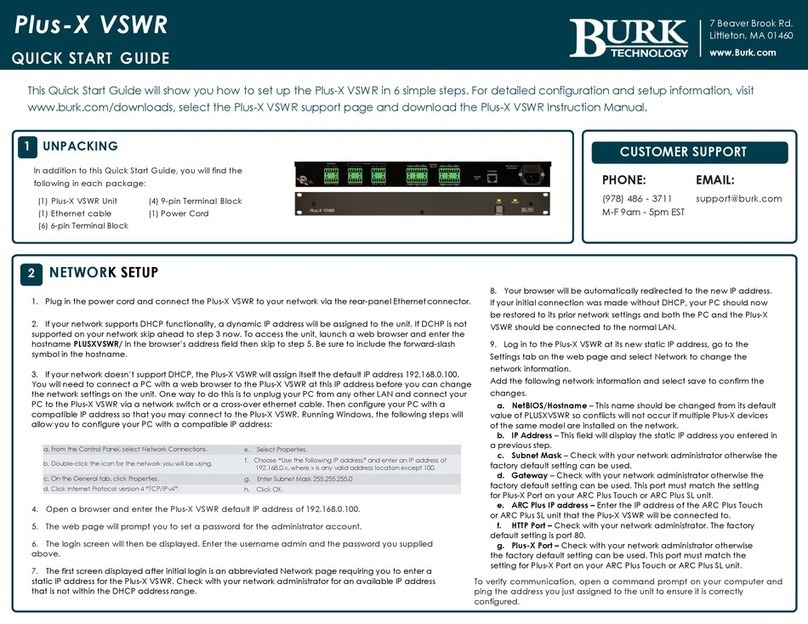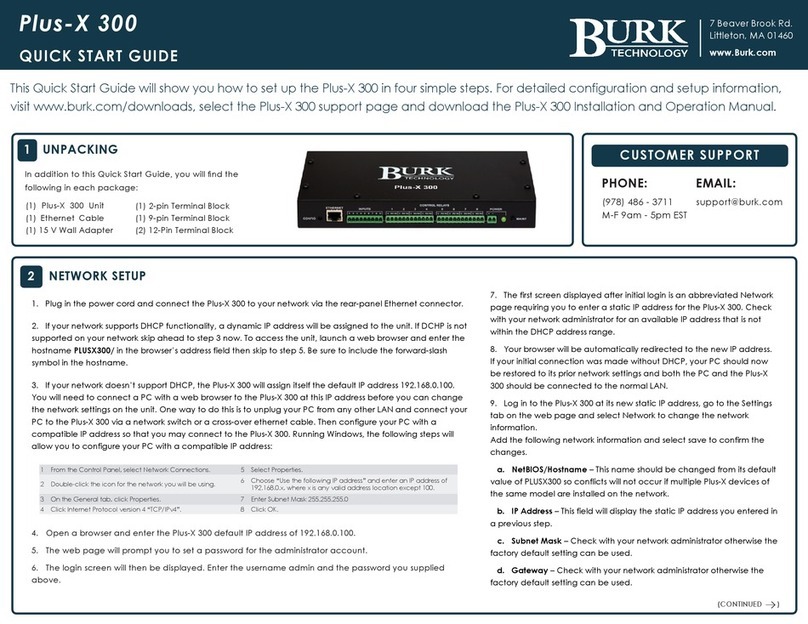
1. To manually map Plus-X channels to the ARC Plus, click the Meter, Status,
or Command tab, as appropriate. Locate an unused channel and click
the … button in the Source column. This will bring up the Source dialog.
Click the Plus-X channel button and choose the Plus-X device and
channel you wish to use.
2. Configure labels, limits, and alarms for the newly added Plus-X channels.
3. Lastly, you will need to calibrate the metering channels. If you have not
already connected the input connector blocks, do so now. Then click
the Calibration icon at the far right of the Source column in the
AutoLoad Plus Meter Channels tab to complete the calibration process.
The Plus-X 600 communicates with the ARC Plus Touch or ARC Plus SL via
LAN/WAN, allowing installation anywhere a network connection is available.
Use AutoLoad Plus to add the
Plus-X device to the ARC Plus
Touch or ARC Plus SL unit. Ensure
you have the current version
of AutoLoad Plus installed on
your computer. To obtain the
current version, visit www.burk.
com/downloads and select the
AutoLoad Plus support page. On
the AutoLoad Plus menu, select
Edit->Plus-X Devices and click Add.
The dialog box shown to the right
will be displayed.
• Select Plus-X 600 and enter its network information.
Note: If adding more than one Plus X device to an ARC Plus, adjust the
starting channel so that other assigned channels are not overwritten.
•Select OK to conrm the rst Plus X device.
•If adding more than one Plus X device, repeat the same steps.
•Save the conguration by selecting File>Save in AutoLoad Plus
To conrm that the Plus-X 600 is communicating, log in to the ARC Plus Touch
or ARC Plus SL using the web browser. All assigned channels should show
their default values.
MANUALLY MAPPING PLUS-X CHANNELS
Note: If the meter or status inputs show as ofine or a warning is displayed,
check the network conguration and ensure the conguration is saved
within AutoLoad Plus.
Refer to the Plus-X 600 Installation and Operation Manual for further
information on conguring and operating the Plus-X 600 unit.
4CONNECTING TO AN ARC PLUS TOUCH OR
ARC PLUS SL
10. To verify communication, open a command prompt on your computer and ping the address
you just assigned to the unit to ensure it is correctly congured.
QUICK START GUIDE
3 CONNECTING STATUS, METERS AND RELAYS ON THE PLUS-X 600
The Plus-X 600 is a versatile I/O solution providing 16 status inputs, 8 metering inputs and 6 raise/
lower command pairs that can be unpaired through the Plus-X 600 web GUI Relay Pairs link.
Connecting a Meter or Status Input
1. Connect your site equipment to the provided 6-pin
push-on block connectors. Notice common ground
is shared between two meter or status channels.
Secure the wires with the built-in setscrews. The status
or metering sample connects to the + terminal, and a
common ground connects to the – terminal.
2. Connect the push-on blocks to the rear panel of the
Plus-X 600 with the setscrews facing up. Be sure to
precisely align the connector terminals to the + and –
contacts on the back panel of the unit.
Connecting a Relay Output
1. Connect your site equipment to the provided nine-
pin push-on block connectors. Secure the wires with
the built-in setscrews. Connections are standard, from
left to right: common (C), normally open (NO), and
normally closed (NC)
2. Connect the push-on blocks to the rear panel of the
Plus-X 600 with the setscrews facing up. Use care to
properly align each terminal with the contacts on the
back panel of the unit.
For information on configuring input and command channels and calibrating meter inputs, see
the Installation & Operation Manual for the Plus-X 600 unit and ARC Plus.
2 NETWORK SETUP (CONTINUED)
e. ARC Plus IP address – Enter the IP address of the ARC Plus Touch or ARC Plus SL unit that
the Plus-X 600 will be connected to.
f. HTTP Port – Check with your network administrator. The factory default setting is port 80.
g. Plus-X Port – Check with your network administrator otherwise the factory default setting
can be used. This port must match the setting for Plus-X Port on your ARC Plus Touch or ARC
Plus SL unit.
Meter Inputs
Status Inputs
Relay Outputs





















